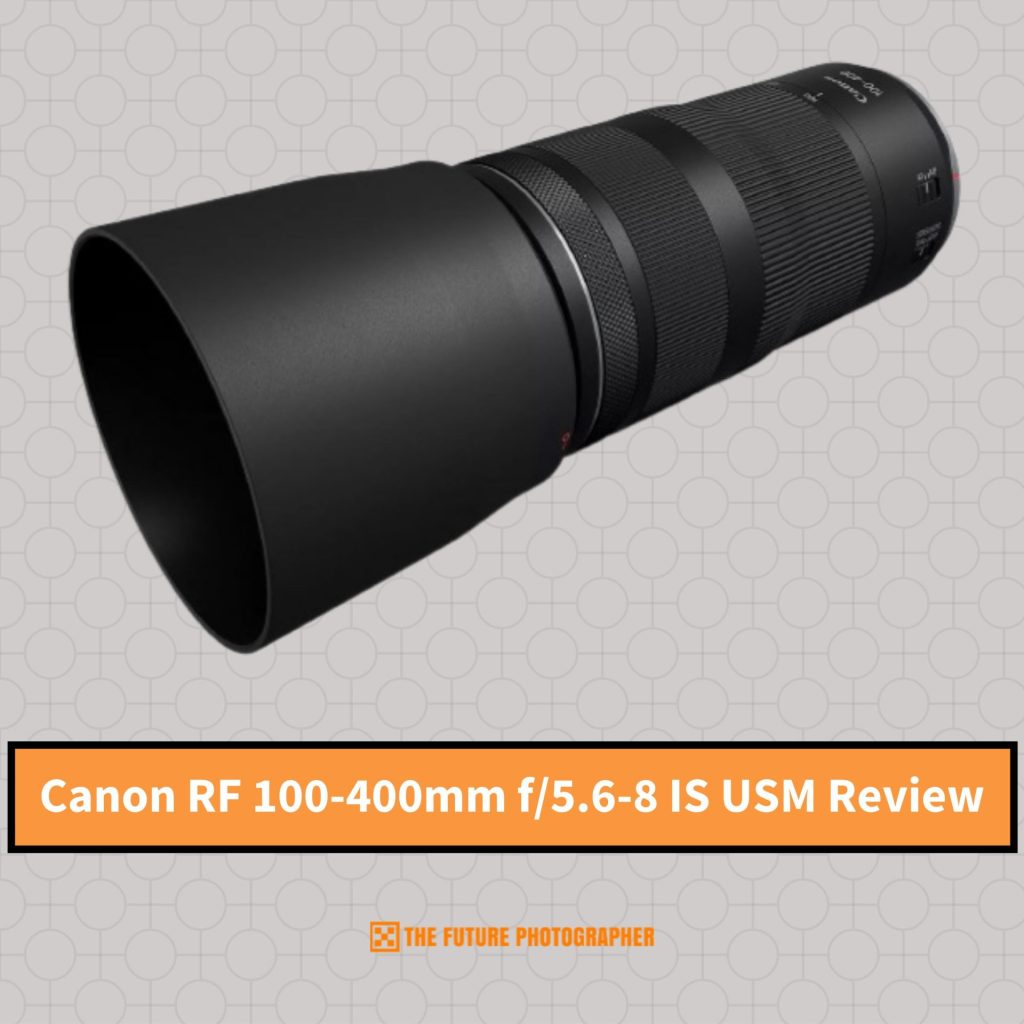
Introduction
The Canon RF 100-400mm f/5.6-8 IS USM telephoto lens is a revelation for photographers using Canon’s EOS R-series cameras. Designed for versatility, this lens brings distant subjects into sharp focus with remarkable ease. Whether you’re capturing wildlife in their natural habitat or athletes on the field, this lens delivers outstanding performance. Moreover, its compact design and affordability make it a must-have for enthusiasts and hobbyists. In this review, we’ll explore why this lens is a fantastic addition to any photographer’s kit. From its build quality to its optical prowess, there’s plenty to love. Let’s dive into what makes the Canon RF 100-400mm a standout choice.
This lens is a budget-friendly option compared to Canon’s premium L-series lenses. Yet, it doesn’t skimp on quality. With a weight of only 635 grams, it’s incredibly lightweight for a telephoto zoom. Consequently, it’s perfect for long shoots or hikes where heavy gear can be a burden. The lens extends to 400mm, offering a versatile zoom range for various scenarios. Additionally, its compatibility with Canon’s RF teleconverters expands its reach even further. This affordability and portability make it ideal for casual photographers and serious hobbyists alike.
Compact Design and Build Quality
The Canon RF 100-400mm f/5.6-8 IS USM is surprisingly compact for its focal range. Measuring 6.5 by 3.1 inches and weighing just 1.4 pounds, it feels like a feather compared to other telephoto lenses. For instance, the RF 100-500mm L-series lens is significantly heavier at 1530 grams. As a result, the RF 100-400mm is a joy to carry on long treks. Its polycarbonate construction is sturdy, ensuring durability without sacrificing portability. Furthermore, the lens features a metal mount for added robustness.
While it lacks the weather sealing of L-series lenses, the build quality is impressive for a non-L lens. The lens barrel extends by about 7.6 centimeters when zoomed to 400mm, but it remains well-balanced. In fact, the weight distribution stays close to the camera body, preventing strain during handheld shooting. Although there’s no tripod collar, the lens’s light weight makes this a minor issue. A customizable control ring adds functionality, allowing adjustments to settings like ISO or aperture. Overall, the design prioritizes practicality and ease of use.
Optical Performance and Image Quality
When it comes to optics, the Canon RF 100-400mm punches above its weight. It features 12 elements in 9 groups, including one Ultra Low Dispersion (UD) element. This design minimizes chromatic aberrations, delivering crisp, colorful images. Additionally, the Super Spectra Coating reduces flare and ghosting, even in challenging lighting. Consequently, photos maintain excellent contrast and clarity across the zoom range. The lens performs particularly well in the center, rivaling more expensive options.
Sharpness is a highlight, especially at 100mm and 400mm. Tests on high-resolution bodies like the Canon EOS R5 show impressive detail. For example, OpticalLimits reported center resolutions of 4758 lw/ph at 100mm and 4370 lw/ph at 400mm on the R5. While edge sharpness drops slightly at 400mm, the center remains tack-sharp. Moreover, the 9-blade circular aperture creates smooth, pleasing bokeh for wildlife and portrait shots. In short, this lens delivers professional-grade image quality at a fraction of the cost.

Autofocus and Stabilization
The Canon RF 100-400mm boasts a Nano USM autofocus system, which is both fast and silent. This makes it ideal for capturing fast-moving subjects like birds or athletes. Paired with cameras like the EOS R5 or R6, the lens locks onto subjects with precision. Furthermore, its eye-detection capabilities excel for wildlife photography, tracking animals effortlessly. However, in low-light conditions, the f/5.6-8 aperture can challenge autofocus performance. Still, for daytime shooting, the focus is reliable and quick.
Image stabilization is another strong suit, offering up to 5.5 stops of optical stabilization. When paired with an EOS R-series camera with In-Body Image Stabilization (IBIS), like the R5 or R6, it achieves 6 stops. This allows for sharp handheld shots at slower shutter speeds. For instance, tests on the EOS R6 showed sharp results at 1/10 second at 400mm. As a result, tripods are often unnecessary, enhancing mobility. This combination of autofocus and stabilization makes the lens a versatile tool.
Versatility Across Genres
One of the standout features of the RF 100-400mm is its versatility. The 100-400mm zoom range covers a wide array of photography genres. For wildlife photographers, it brings distant animals into clear view. Similarly, sports photographers can capture action from the sidelines with ease. Additionally, the lens is great for landscape photography, compressing distant scenes beautifully. Its compact size makes it a perfect travel companion for family adventures or outdoor trips.
The lens also shines in close-up photography, with a maximum magnification of 0.41x at 400mm. At its minimum focus distance of 0.88 meters, you can fill the frame with a subject the size of a credit card. This capability adds a near-macro dimension to its repertoire. Consequently, photographers can capture detailed shots of small subjects like flowers or insects. The RF 100-400mm’s ability to handle diverse scenarios makes it a fantastic all-around lens.
Teleconverter Compatibility
Unlike many non-L-series lenses, the RF 100-400mm is compatible with Canon’s RF 1.4x and 2x teleconverters. This extends the focal length to 560mm or 800mm, respectively. As a result, photographers can achieve incredible reach without investing in a pricier lens. For example, with the 2x teleconverter, the lens becomes a 200-800mm f/11-16 zoom. This is perfect for birding or other scenarios requiring extreme telephoto reach.
However, the trade-off is a reduced maximum aperture, which can limit performance in low light. With the 1.4x teleconverter, the aperture becomes f/8-11, and with the 2x, it’s f/11-16. Additionally, diffraction can affect sharpness at these smaller apertures, especially on high-resolution cameras. Nevertheless, the ability to zoom across the entire range with teleconverters sets this lens apart. It offers flexibility that even the RF 100-500mm L-series lens can’t match in this regard.
Real-World Performance
In real-world use, the Canon RF 100-400mm excels in bright conditions. Photographers report sharp, vibrant images when shooting wildlife or sports in daylight. For instance, a user on the Canon Community praised its performance for bird photography on the EOS R7. The lens’s lightweight design makes it easy to carry for extended periods. Furthermore, its fast autofocus keeps up with erratic subjects like birds in flight. This reliability is crucial for capturing fleeting moments.
However, the lens’s f/5.6-8 aperture can be a limitation in low light. Indoor sports or evening shoots may require high ISOs, which can introduce noise. Still, modern EOS R cameras handle high ISOs well, mitigating this drawback. Additionally, the lack of weather sealing means caution is needed in harsh conditions. Despite these limitations, the lens performs admirably for its price point. Its real-world results often exceed expectations for a budget telephoto zoom.

Comparison to Alternatives
Compared to the RF 100-500mm f/4.5-7.1 L IS USM, the RF 100-400mm is a more affordable option. The L-series lens offers superior sharpness and weather sealing but costs over $2,800. In contrast, the RF 100-400mm delivers comparable center sharpness at a fraction of the price. Additionally, its lighter weight makes it more practical for casual use. For photographers who don’t need pro-grade features, the RF 100-400mm is a compelling choice.
When compared to adapted EF lenses like the Sigma or Tamron 100-400mm, the RF 100-400mm has advantages. It’s lighter and doesn’t require an EF-RF adapter, reducing bulk. Moreover, its Nano USM autofocus is faster than many third-party options. While Sigma and Tamron lenses may offer slightly brighter apertures, they’re heavier and more expensive. Thus, the RF 100-400mm strikes an excellent balance of performance, portability, and cost.
Value for Money
At $699, the Canon RF 100-400mm offers unbeatable value. Few full-frame telephoto zooms reach 400mm at this price point. For comparison, the Sigma 100-400mm f/5-6.3 costs around $800 and requires an adapter for EOS R cameras. The RF 100-400mm’s combination of sharpness, stabilization, and autofocus performance is remarkable for its cost. Additionally, its compatibility with teleconverters adds versatility without breaking the bank.
The lens’s lightweight design and compact size further enhance its value. Photographers can carry it all day without fatigue, unlike heavier alternatives. Furthermore, its image quality rivals more expensive lenses in good lighting. For hobbyists or those new to telephoto photography, this lens is an accessible entry point. It delivers professional results without the professional price tag.

Practical Tips for Using the Lens
To get the most out of the RF 100-400mm, shoot in good lighting whenever possible. The f/5.6-8 aperture performs best in daylight, ensuring sharp images and fast shutter speeds. Additionally, use the lens’s image stabilization for handheld shooting at slower speeds. For wildlife, pair it with a camera like the EOS R5 or R7 for optimal autofocus performance. The eye-detection feature is a game-changer for tracking animals.
When using teleconverters, be mindful of the reduced aperture. Stick to bright conditions to maintain image quality and autofocus speed. Also, consider enabling Canon’s Digital Lens Optimizer (DLO) in-camera or in post-processing. This corrects minor aberrations, enhancing sharpness. Finally, protect the lens in dusty or wet conditions, as it lacks weather sealing. With these tips, you’ll maximize the lens’s potential.
Limitations and Considerations
While the RF 100-400mm is impressive, it has some limitations. The variable f/5.6-8 aperture is relatively slow, making low-light shooting challenging. Consequently, photographers may need to increase ISO or use a tripod in dim conditions. Additionally, the lack of weather sealing means it’s not ideal for harsh environments. Dust or moisture could damage the lens over time.
The lens also lacks a tripod collar, which may inconvenience tripod users. However, its lightweight reduces the need for one in most cases. Furthermore, edge sharpness at 400mm isn’t as strong as in the center. For most telephoto applications, though, the center is what matters most. These drawbacks are minor given the lens’s price and performance.

Why It’s a Must-Have for EOS R Users
For EOS R-series users, the RF 100-400mm is a no-brainer. Its native RF mount ensures seamless integration with Canon’s mirrorless cameras. Unlike adapted EF lenses, it doesn’t require an adapter, keeping the setup compact. Moreover, its fast Nano USM autofocus and stabilization complement the advanced features of cameras like the R5 and R6. This synergy results in a fluid shooting experience.
The lens’s affordability makes it accessible to a wide range of photographers. Whether you’re a beginner or a seasoned hobbyist, it delivers results that punch above its price. Additionally, its versatility across genres—from wildlife to sports to landscapes—makes it a valuable addition to any kit. For those seeking a lightweight, high-performing telephoto zoom, the RF 100-400mm is hard to beat.
Community Feedback and Real-World Examples
Photographers across forums like Reddit and Canon Community praise the RF 100-400mm. A Reddit user with an EOS R7 called it a “fantastic” choice for bird photography, citing its light weight and sharp images. Another user on DPR Forums highlighted its close-up capabilities, sharing stunning bird shots. These real-world examples underscore the lens’s ability to deliver in demanding scenarios.
Professional reviewers also laud its performance. Digital Camera World noted its “highly impressive” image quality and fast autofocus. Similarly, PetaPixel called it a “simple yet effective” telephoto zoom. These endorsements, combined with user feedback, confirm the lens’s reliability. It’s a lens that consistently exceeds expectations for its class.
Conclusion: A Telephoto Triumph
In conclusion, the Canon RF 100-400mm f/5.6-8 IS USM is a triumph of design and performance. Its compact size, lightweight build, and sharp optics make it a standout choice. Furthermore, its fast autofocus and effective stabilization enhance its usability. While it has limitations, such as a slow aperture and lack of weather sealing, these are minor compared to its strengths. For EOS R-series users, it’s an affordable, versatile telephoto zoom.
This lens proves that innovation isn’t reserved for expensive gear. It delivers professional-quality results at a consumer-friendly price. Whether you’re photographing birds, sports, or landscapes, the RF 100-400mm excels. Its compatibility with teleconverters and close-up capabilities add even more value. For anyone looking to expand their telephoto reach, this lens is a fantastic investment. It’s a tool that will inspire creativity and capture stunning moments.
